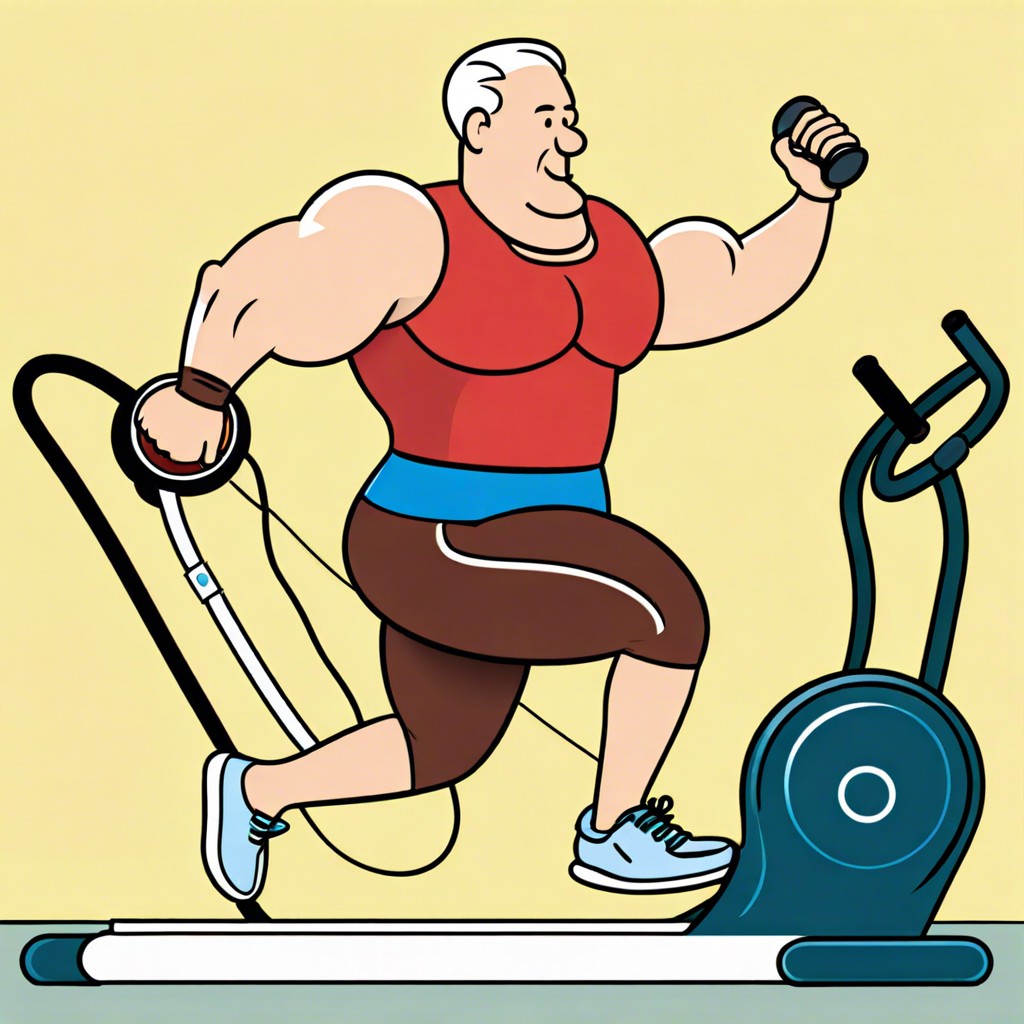Wondering how your blood pressure reacts to exercise?
Feeling the squeeze about how your blood pressure reacts to exercise? Fear not—this isn’t just another boring doc speak. We’ll uncover how your BP behaves when breaking a sweat, from the immediate roller coaster of systolic spikes to the long-term heart health perks. Whether you’re hitting the treadmill or liftin’ weights, we’ve got your back. Curious about age, gender, or how the fit folks fare versus couch enthusiasts? Yep, we’ll spill those beans, too. Let’s dive into the heart-pounding, sweat-dripping tale of your blood pressure’s response to exercise!
Key takeaways:
- Immediate systolic blood pressure increase: Normal during exercise.
- Diastolic blood pressure stability: Remains steady during workouts.
- Long-term blood pressure benefits: Improved with regular exercise.
- Exercise intensity impact: Higher intensity spikes blood pressure.
- Cardiovascular adaptations over time: Heart becomes more efficient.
Immediate Systolic Blood Pressure Increase

So, here you are, sweating through your workout, wondering why your systolic blood pressure spikes like a soda can dropped from the top shelf. No need to fret. It’s all part of the plan.
As you exercise, your muscles clamor for more oxygen. The heart responds by pumping harder and faster, sending blood on a thrilling roller-coaster ride through your vessels, amping up systolic pressure.
Think of it like cranking up the volume on your favorite playlist. More power, more push. Systolic blood pressure gets a temporary boost to meet the increased demands. It’s teamwork between your heart and muscles.
And guess what? That elevated number? It’s a sign of your body kicking into high gear, making sure every cell gets a VIP oxygen delivery. Just remember, it’s a short-lived bump, not your new normal.
Exercise triggers a symphony of biological reactions, and your circulatory system is the maestro. Soak in the rise. Embrace the pump.
Diastolic Blood Pressure Stability
While systolic pressure enjoys its moment in the spotlight, diastolic pressure tends to stay more reserved during exercise. It’s the introvert at the blood pressure party, mostly hanging out in the corner.
Unlike systolic pressure, which revels in increasing as your heart pumps more blood to your muscles, diastolic pressure remains relatively stable. Why? Because the blood vessels dilate to accommodate the increased blood flow, preventing diastolic pressure from rising significantly.
Think of it like your arteries throwing open their doors to make more room – it’s all about balance, like trying to squeeze more guests into a party without overcrowding.
Different types of exercise can affect it differently, but generally, steady-state activities like jogging or cycling won’t cause drastic fluctuations in diastolic pressure.
For those worried about numbers, this is usually good news. It means your heart’s relaxation phase isn’t put under undue stress even when you’re going full throttle on the treadmill. So, while your heart’s doing the cha-cha, your diastolic pressure is more of a wallflower, and that’s perfectly okay.
Long-term Blood Pressure Regulation Benefits
Regular exercise can be a game-changer for maintaining healthy blood pressure levels. Picture your arteries as those bendy straws. Over time, consistent physical activity keeps them flexible and efficient.
First, exercise enhances the heart’s ability to pump blood, reducing the effort needed to circulate it. Imagine getting a stronger engine in your car; everything just runs smoother.
Secondly, regular workouts help manage body weight, which is crucial for blood pressure. Carrying around fewer pounds is like easing the load on a pack mule—less strain means less spike in pressure.
Lastly, exercise boosts the production of nitric oxide in blood vessels, helping them relax and widen. It’s like turning your garden hose nozzle to a gentler setting, ensuring a smoother water flow.
These steady routine changes can contribute to a significant drop in blood pressure, often comparable to what you’d see with medication. Plus, side effects like endorphin boosts aren’t too shabby either.
Impact of Exercise Intensity On Blood Pressure Response
Intensity plays a dramatic role in how our blood pressure reacts during exercise. When you crank up the intensity, your systolic pressure—the top number on your blood pressure reading—tends to spike. It’s like your heart becomes a caffeinated squirrel, pumping with extra vigor to deliver oxygen to your muscles.
On the other hand, moderate-intensity activities, like a brisk walk or easy jog, lead to a more gentle rise. It’s like asking politely versus yelling at the top of your lungs. Your heart still works harder, but it’s not under siege.
Interestingly, high-intensity interval training (HIIT) can cause significant immediate spikes, but it has been shown to lower average blood pressure over time. It’s like charging up a battery—quick bursts that fuel long-term gains.
Remember, our body’s response is as unique as a fingerprint. One person’s sprint is another’s stroll. Matching the intensity to your fitness level is key.
Navigating these nuances lets you tailor workouts that make your blood pressure behave like a Shakespearean drama—full of action but balanced by a satisfying ending.
Cardiovascular Adaptations Over Time
Your heart is like that one friend who loves the gym more than donuts—committed and adaptive. Over time, regular exercise transforms your cardiovascular system into a well-oiled machine. Let’s break it down:
First, your heart becomes more efficient. It doesn’t need to work as hard to pump blood; thus, it beats slower at rest. Think of it as getting a raise without having to do extra work.
Also, your blood vessels become more flexible. Instead of acting like rigid drinking straws, they turn into happy, elastic garden hoses. This flexibility helps manage blood pressure more effectively.
Finally, your overall blood volume increases. More blood means better transportation of oxygen and nutrients, like having more Uber drivers during rush hour. Everyone gets where they need to go smoothly.
It’s like upgrading from a rickety old bike to a high-performance roadster—tougher, faster, and much more reliable. More than just muscles grow stronger; your entire cardiovascular network steps up its game.
Role of Different Types of Exercise (Aerobic Vs. Anaerobic)
Aerobic exercise, like running and swimming, gently nudges your heart into a rhythmic symphony, boosting oxygen supply to muscles and making blood vessels more flexible. This can lead to a gradual decrease in blood pressure over time, as your cardiovascular system becomes more efficient.
On the flip side, anaerobic exercise, such as weightlifting or sprinting, gives your heart a high-intensity jolt. Picture it like revving an engine to full throttle. This can cause spikes in blood pressure during the activity, but don’t worry, it’s normal. These activities strengthen heart muscles and arteries, leading to lasting blood pressure benefits.
So, whether you’re channeling your inner gazelle or Hulk, both types of exercise offer unique perks. Choose a mix of both for a holistic heart health strategy.
Blood Pressure Variability in Trained Vs. Untrained Individuals
And here’s where the rubber meets the road: trained and untrained individuals have different blood pressure responses during exercise. Imagine throwing a couch potato and a marathoner on a treadmill. Cue the dramatic music.
Here’s why: trained folks develop more efficient cardiovascular systems. Their heart muscles are more robust, they have better vascularization, and their bodies simply know how to handle the extra load. Translation? Their systolic blood pressure rises more gradually, and the overall strain on the heart is less intense.
In contrast, untrained individuals? Picture your noisy old lawnmower trying to function. Their hearts have to work harder, leading to a steeper spike in blood pressure. Their bodies are like, “Whoa, what’s happening?”
The trained body also recovers faster. It’s like a well-oiled machine that cools down quickly. The untrained system, on the other hand, keeps grumbling long after the workout ends.
So, getting fit? Not just for show—you’re literally re-tuning your body’s internal engine.
Age-Related Differences in Blood Pressure Response to Exercise
As people age, their cardiovascular system inevitably changes. This can impact how their blood pressure responds to exercise. Let’s break down some key points to understand these differences.
First, older adults often experience a greater increase in systolic blood pressure during physical activity compared to their younger counterparts. Why? Because their arteries are less elastic, making it harder for blood to flow smoothly.
Secondly, the heart’s efficiency can decrease with age. This means seniors might need to pump more vigorously during exercise, leading to more pronounced blood pressure spikes.
On a bright note, regular exercise can help mitigate these effects. Consistent activity can improve arterial flexibility and overall heart health, making those blood pressure jumps less severe over time.
However, older adults should be mindful of the intensity and type of exercise they choose. Low to moderate-intensity workouts tend to be easier on the cardiovascular system, providing benefits without excessive strain.
In short, while age factors into blood pressure response, maintaining an active lifestyle can work wonders in keeping those numbers in check.
Gender-Specific Blood Pressure Responses
Men and women experience exercise differently, and this extends to blood pressure responses. Think of exercise as a dance; it seems men and women have their own unique rhythms.
For men, blood pressure generally rises more sharply during exercise. This spike can be attributed to higher muscle mass and more vigorous cardiac output. Picture a guy lifting heavy weights and his heart saying, “I’ve got this!”
Women, on the other hand, tend to have a more moderated response. Estrogen levels play a role here, as this hormone provides a sort of cardiovascular cushion. It’s like their hearts are multitasking—doing the cardio while also stress-managing.
Furthermore, post-menopausal women experience a shift. With lower estrogen levels, their hearts start dancing more like men’s, showing a similar sharp rise in blood pressure during exercise. So essentially, women’s bodies adapt as they age, changing the tempo.
Understanding these differences can help in tailoring fitness routines and health advice, ensuring everyone gets a safe and effective workout that respects their unique cardiovascular melody.
Safety Considerations and Precautions
Remember, while getting your heart pumping can be exhilarating, it’s essential to keep a few things in mind:
Start slow, especially if you’re new to exercise. Rome wasn’t built in a day, and neither are your muscles.
Stay hydrated. Water, not coffee. Your heart will appreciate fewer jolts.
Listen to your body. Chest pain is not a suggestion; it’s a stop sign.
Don’t skip the warm-up or cool-down. Your heart isn’t a microwave; it needs gradual changes.
Consult your doctor, particularly if you have existing health conditions. Better to ask now than regret later.
If you feel dizzy or overly fatigued, ease up. Exercise should invigorate, not incapacitate.
Remember, exercise is your friend, not a drill sergeant.




